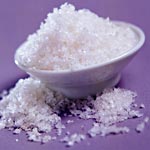Salt is everywhere and in everything from pet food to baby food. It is so caustic to the sensitive inner tissues of the body that water is retained to neutralize its acidic effect. This adds weight to the body. Overuse of salt can contribute to a severe affliction of the kidneys called nephritis.
When you consider that many people consume coffee, tea, soda pop, alcohol, supplements, and salt every day, all of which must be excreted by the kidneys, it is no small wonder why so many people die annually from kidney failure. Whatever we can do to save our poor overworked kidneys should be done.
Keep Salt Intake Low and Potassium Intake High
Excessive consumption of salt (sodium chloride), coupled with low levels of dietary potassium, greatly stresses the kidneys’ ability to maintain proper fluid volume. As a result, some people become “salt-sensitive”. For them, high salt intake causes high blood pressure or water retention. In order to avoid becoming salt-sensitive, you must not only reduce salt intact, but simultaneously increase your intake of potassium. This is easily done by increasing your intake of high-potassium foods and avoiding high-sodium foods (most processed foods). Read labels carefully to keep your total daily sodium intake below 1,800 mg.
Numerous studies have demonstrated that a low-potassium, high-sodium diet plays a major role in the development of cancer and cardiovascular diseases (heart diseases, high blood pressure, strokes).
Over ninety-five percent of the potassium in the body is found within cells. In contrast, most of the sodium in the body is located outside the cells in the blood and other fluids. Cells pump sodium out and potassium in via the sodium-potassium pump.
This pump is found in the membranes of all cells in the body,
and is perhaps the most important aspect
of maintaining cellular health.
If body potassium requirements are not being met through diet, supplementation is essential to good health. This statement is particularly true for the athletes, elderly, and people with high blood pressure
|
|
High-Potassium foods
in portion and milligrams: Asparagus (1/2 cup = 165),
Avocado (1/2 = 680),
Raw carrot (1 = 225),
Lima beans (1/2 cup = 581),
Spinach (1/2 cup = 292),
Raw tomato (1 medium = 444),
Apple (1 medium = 182),
Dried Apricots (1/4 cup = 318),
Banana (1 medium = 440),
Peach (1 medium = 308),
Plums (5 = 150),
Chicken-light meat (3 ounces = 350),
Lamb-leg (3 ounces = 241),
Roast beef (3ounces = 224),
Cod (3 ounces = 345),
Haddock (3 ounces = 297). |

For those who wish to continue using salt, we recommend natural ground sea salt. Ground sea salt can be used in a salt grinder. Or use the so-called salt substitutes, such as the popular brands NoSalt and NU-Salt. These products are composed of potassium chloride, which tastes very similar to sodium chloride. |
|